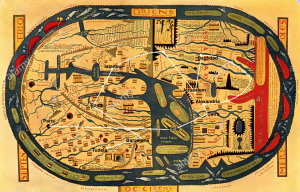After mapping Benjamin of Tudela’s route on both a modern map and St. Beatus of Liebana’s Mappa Mundi, there are some clear differences between the two maps and cartography of each time period. The most obvious difference between the modern map and Beatus map is that the Middle East and Asia are at the top of the Beatus map. There is a depiction of Adam and Eve in the Garden of Eden accompanying these locations at the top of the map because Earthly Paradise was supposed to be somewhere in the “unexplored” areas of the East.
The style of the Mappa Mundi is a T and O map meaning, representing only one half of the Earth. One would notice that only Europe, the Middle East and parts of the Asian and African continents are pictured. The ‘T’ represents the land, and the surrounding ‘O’ represents the water surrounding it. Jerusalem is strategically placed in the middle of St. Beatus’ Mappa Mundi due to its religious significance for Christians, Jews, and Muslims alike.
The Beatus Map is, however, written in English, which is interesting because it was written by a Spanish monk, St. Beatus of Liebana based upon accounts from St. Isadore of Seville, Ptolemy, and the Bible. This map’s purpose was not to be exactly accurate (which it was not going to be due to the West’s knowledge of the rest of the world) but to depict the Diaspora of the Apostles.
When examining Benjamin’s travels on both the modern map and the Beatus Map, they do look similar in comparison, just flipped. With the exception of the far east, all of Benjamin’s travel locations do appear on the Beatus Map. It makes sense that, although oriented differently from the modern map, and despite the T and O style layout, most of Benjamin’s locations are accounted for. This is because The Beatus Map was arguably the most important map that came out of the Early Middle Ages. Benjamin also traveled mostly in the West and Middle East, so most of the locations are present in the Beatus Map.
Looking at these maps and all of the locations to where Benjamin traveled, it is difficult to believe that he did, in fact, travel to China, Tibet, and India with few stops along the way. Benjamin gives fairly detailed accounts for numerous locations throughout Europe, the Middle East, and Africa. There is a stark contrast between those accounts and the accounts of his “travels” in the far east. Especially because the Beatus map was a prominent map during the time of Benjamins travels, the fact that it does not depict India and East Asia would cause one to believe that he did not actually travel there.
